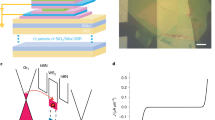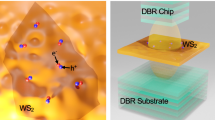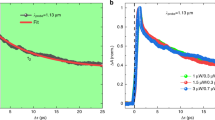Abstract
Interactions of quantum materials with strong laser fields can induce exotic non-equilibrium electronic states1,2,3,4,5,6. Monolayer transition metal dichalcogenides, a new class of direct-gap semiconductors with prominent quantum confinement7, offer exceptional opportunities for the Floquet engineering of excitons, which are quasiparticle electron–hole correlated states8. Strong-field driving has the potential to achieve enhanced control of the electronic band structure and thus the possibility of opening a new realm of exciton light–matter interactions. However, a full characterization of strong-field driven exciton dynamics4,9 has been difficult. Here we use mid-infrared laser pulses below the optical bandgap to excite monolayer tungsten disulfide and demonstrate strong-field light dressing of excitons in excess of a hundred millielectronvolts. Our high-sensitivity transient absorption spectroscopy further reveals the formation of a virtual absorption feature below the 1s-exciton resonance, which we assign to a light-dressed sideband from the dark 2p-exciton state. Quantum-mechanical simulations substantiate the experimental results and enable us to retrieve real-space movies of the exciton dynamics. This study advances our understanding of the exciton dynamics in the strong-field regime, showing the possibility of harnessing ultrafast, strong-field phenomena in device applications of two-dimensional materials.
This is a preview of subscription content, access via your institution
Access options
Access Nature and 54 other Nature Portfolio journals
Get Nature+, our best-value online-access subscription
$29.99 / 30 days
cancel any time
Subscribe to this journal
Receive 12 print issues and online access
$209.00 per year
only $17.42 per issue
Buy this article
- Purchase on Springer Link
- Instant access to full article PDF
Prices may be subject to local taxes which are calculated during checkout




Similar content being viewed by others
Data availability
Source data are provided with this paper. All other data that support the plots within this paper and other findings of this study are available from the corresponding author upon reasonable request.
Code availability
The codes that support the findings of this study are available from the corresponding author upon reasonable request.
References
Wagner, M. et al. Observation of the intraexciton autler-townes effect in GaAs/AlGaAs semiconductor quantum wells. Phys. Rev. Lett. 105, 167401 (2010).
Teich, M. et al. Systematic investigation of terahertz-induced excitonic Rabi splitting. Phys. Rev. B 89, 115311 (2014).
Uchida, K. et al. Time-resolved observation of coherent excitonic nonlinear response with a table-top narrowband THz pulse wave. Appl. Phys. Lett. 107, 221106 (2015).
Langer, F. et al. Lightwave valleytronics in a monolayer of tungsten diselenide. Nature 557, 76–80 (2018).
McIver, J. W. et al. Light-induced anomalous hall effect in graphene. Nat. Phys. 16, 38–41 (2020).
Baykusheva, D. et al. All-optical probe of three-dimensional topological insulators based on high-harmonic generation by circularly polarized laser fields. Nano Lett. 21, 8970–8978 (2021).
Mak, K. F., Lee, C., Hone, J., Shan, J. & Heinz, T. F. Atomically thin MoS2: a new direct-gap semiconductor. Phys. Rev. Lett. 105, 136805 (2010).
Wang, G. et al. Colloquium: excitons in atomically thin transition metal dichalcogenides. Rev. Mod. Phys. 90, 021001 (2018).
Zaks, B., Liu, R. B. & Sherwin, M. S. Experimental observation of electron–hole recollisions. Nature 483, 580–583 (2012).
Kim, J. et al. Ultrafast generation of pseudo-magnetic field for valley excitons in WSe2 monolayers. Science 346, 1205–1208 (2014).
Sie, E. J. et al. Valley-selective optical stark effect in monolayer WS2. Nat. Mater. 14, 290–294 (2015).
Ye, Z., Sun, D. & Heinz, T. F. Optical manipulation of valley pseudospin. Nat. Phys. 13, 26–29 (2017).
Yong, C.-K. et al. Biexcitonic optical stark effects in monolayer molybdenum diselenide. Nat. Phys. 14, 1092–1096 (2018).
Cunningham, P. D., Hanbicki, A. T., Reinecke, T. L., McCreary, K. M. & Jonker, B. T. Resonant optical stark effect in monolayer WS2. Nat. Commun. 10, 5539 (2019).
Yong, C.-K. et al. Valley-dependent exciton fine structure and autler–townes doublets from berry phases in monolayer MoSe2. Nat. Mater. 18, 1065–1070 (2019).
Morrow, D. J. et al. Quantum interference between the optical stark effect and resonant harmonic generation in WS2. Phys. Rev. B 102, 161401 (2020).
Shi, J. et al. Room temperature terahertz electroabsorption modulation by excitons in monolayer transition metal dichalcogenides. Nano Lett. 20, 5214–5220 (2020).
Earl, S. K. et al. Coherent dynamics of floquet-bloch states in monolayer WS2 reveals fast adiabatic switching. Phys. Rev. B 104, L060303 (2021).
LaMountain, T. et al. Valley-selective optical stark effect of exciton-polaritons in a monolayer semiconductor. Nat. Commun. 12, 4530 (2021).
Brabec, T. & Krausz, F. Intense few-cycle laser fields: frontiers of nonlinear optics. Rev. Mod. Phys. 72, 545 (2000).
Ghimire, S. et al. Observation of high-order harmonic generation in a bulk crystal. Nat. Phys. 7, 138–141 (2011).
Lucchini, M. et al. Attosecond dynamical Franz-Keldysh effect in polycrystalline diamond. Science 353, 916–919 (2016).
Silva, R. E. F., Jiménez-Galán, Á., Amorim, B., Smirnova, O. & Ivanov, M. Topological strong-field physics on sub-laser-cycle timescale. Nat. Photon. 13, 849–854 (2019).
Chernikov, A. et al. Exciton binding energy and nonhydrogenic rydberg series in monolayer WS2. Phys. Rev. Lett. 113, 076802 (2014).
Poellmann, C. et al. Resonant internal quantum transitions and femtosecond radiative decay of excitons in monolayer WSe2. Nat. Mater. 14, 889–893 (2015).
Ajayi, O. A. et al. Approaching the intrinsic photoluminescence linewidth in transition metal dichalcogenide monolayers. 2D Mater. 4, 031011 (2017).
Liu, F. et al. Disassembling 2D van der Waals crystals into macroscopic monolayers and reassembling into artificial lattices. Science 367, 903–906 (2020).
Ye, Z. et al. Probing excitonic dark states in single-layer tungsten disulphide. Nature 513, 214–218 (2014).
Lindberg, M. & Koch, S. W. Transient oscillations and dynamic stark effect in semiconductors. Phys. Rev. B 38, 7607 (1988).
Shirley, J. H. Solution of the Schrödinger equation with a Hamiltonian periodic in time. Phys. Rev. 138, B979 (1965).
Sambe, H. Steady states and quasienergies of a quantum-mechanical system in an oscillating field. Phys. Rev. A 7, 2203 (1973).
Jauho, A. P. & Johnsen, K. Dynamical Franz-Keldysh effect. Phys. Rev. Lett. 76, 4576 (1996).
Nordstrom, K. B. et al. Excitonic dynamical Franz-Keldysh effect. Phys. Rev. Lett. 81, 457 (1998).
Tsuji, N., Oka, T. & Aoki, H. Correlated electron systems periodically driven out of equilibrium: Floquet + DMFT formalism. Phys. Rev. B 78, 235124 (2008).
Keldysh, L. V. Coulomb interaction in thin semiconductor and semimetal films. JETP Lett. 29, 716–719 (1979).
Berkelbach, T. C., Hybertsen, M. S. & Reichman, D. R. Theory of neutral and charged excitons in monolayer transition metal dichalcogenides. Phys. Rev. B 88, 045318 (2013).
Wu, M., Chen, S., Camp, S., Schafer, K. J. & Gaarde, M. B. Theory of strong-field attosecond transient absorption. J. Phys. B: At. Mol. Opt. Phys. 49, 062003 (2016).
Chini, M. et al. Sub-cycle oscillations in virtual states brought to light. Sci. Rep. 3, 1105 (2013).
Ott, C. et al. Reconstruction and control of a time-dependent two-electron wave packet. Nature 516, 374–378 (2014).
Kruchinin, S. Y., Krausz, F. & Yakovlev, V. S. Colloquium: strong-field phenomena in periodic systems. Rev. Mod. Phys. 90, 021002 (2018).
Liu, H. et al. High-harmonic generation from an atomically thin semiconductor. Nat. Phys. 13, 262–265 (2017).
Higuchi, T., Heide, C., Ullmann, K., Weber, H. B. & Hommelhoff, P. Light-field-driven currents in graphene. Nature 550, 224–228 (2017).
Colbert, D. T. & Miller, W. H. A novel discrete variable representation for quantum mechanical reactive scattering via the S-matrix Kohn method. J. Chem. Phys. 96, 1982 (1992).
Glutsch, S., Chemla, D. S. & Bechstedt, F. Numerical calculation of the optical absorption in semiconductor quantum structures. Phys. Rev. B 54, 11592 (1996).
Zhang, T. Y. & Zhao, W. Franz-Keldysh effect and dynamical Franz-Keldysh effect of cylindrical quantum wires. Phys. Rev. B 73, 245337 (2006).
Acknowledgements
We thank J. Shi and I. Franco for discussions. This work was primarily supported by the US Department of Energy, Office of Science, Basic Energy Sciences, Chemical Sciences, Geosciences, and Biosciences Division through the AMOS program. F.L. was supported by the Terman Fellowship and startup funds from the Department of Chemistry at Stanford University. Y.K. acknowledges support from the Urbanek–Chorodow Fellowship at Stanford University and C.H. acknowledges support from the W. M. Keck Foundation and an Alexander von Humboldt Research Fellowship.
Author information
Authors and Affiliations
Contributions
Y.K. and C.H. performed the experiments. A.C.J. and F.L. fabricated the sample. Y.K. performed the simulations and analysed the results. F.L., D.A.R., T.F.H. and S.G. supervised the project. V.T. performed supplementary calculations. All authors contributed to the preparation of the manuscript.
Corresponding authors
Ethics declarations
Competing interests
The authors declare no competing interests.
Peer review
Peer review information
Nature Physics thanks the anonymous reviewers for their contribution to the peer review of this work.
Additional information
Publisher’s note Springer Nature remains neutral with regard to jurisdictional claims in published maps and institutional affiliations.
Supplementary information
Supplementary Information
Supplementary Figs. 1–9 and Discussions.
Source data
Source Data Fig. 1e
Source data for Fig. 1e.
Source Data Fig. 3d
Source data for Fig. 3d.
Source Data Fig. 3e
Source data for Fig. 3e.
Rights and permissions
Springer Nature or its licensor (e.g. a society or other partner) holds exclusive rights to this article under a publishing agreement with the author(s) or other rightsholder(s); author self-archiving of the accepted manuscript version of this article is solely governed by the terms of such publishing agreement and applicable law.
About this article
Cite this article
Kobayashi, Y., Heide, C., Johnson, A.C. et al. Floquet engineering of strongly driven excitons in monolayer tungsten disulfide. Nat. Phys. 19, 171–176 (2023). https://doi.org/10.1038/s41567-022-01849-9
Received:
Accepted:
Published:
Issue Date:
DOI: https://doi.org/10.1038/s41567-022-01849-9



